For many, elk is the most prized of game animals. The trophy of a bull elk head is something awe-inspiring. Their magnificent antlers, their strong necks and shoulders, and their large bashful eyes make for a stunning creature to hang on the mantle. Elk hunting itself can be a hair-raising experience. The suspense of tracking quietly through the forest, remaining hidden four hours on end in the brush or trees, and listening to nothing but the silent calls of the forest make the art of elk hunting as majestic as the animal itself. If you are interested in hunting elk, here are three little known facts to get you started.
The Anatomy of an Antler
Typically, the most prized part of the elk is its antlers, making this animal so distinct among its deer cousins. As the largest of the deer family, it is no surprise that elk also have the largest antlers. Only male elk grow antlers, which start growing in the spring and are always shed in the winter. The largest antlers reach about four feet tall, and can weigh over 40 pounds. The antlers themselves are made out of bone, which makes their quick growth rate astonishing—they can grow upward of 0.9 inches a day! Like all deer, their antlers are covered in a soft layer of skin known as velvet. This velvet is vascularized, which means it helps provide the blood flow and nutrients required to grow the antlers.
While it is common knowledge that only male elk grow antlers, some cow elk have been observed to grow antlers. This is incredibly rare, but it is not unheard of.
Elk are Athletic
Hunting an elk is no easy task—elk have evolved for thousands of years to beat out predators. They may be no match for modern hunting rifles and weaponry, but they are still a stealthy creature and require special hunting tactics. For example, they can reach a maximum speed of 45 miles per hour. If an elk comes within range, you never want to spook it or you may lose that trophy. In addition, elk can jump very high. Despite being large and sturdy animals, their vertical jump height can reach a maximum of eight feet. They need to be able to do this to avoid predators in the rugged mountain terrain of their home. Hunting elk takes a lot of patience, lest your prize dart out of range.
Elk Vocalize in a Range of Ways
One of the first things you will learn about elk hunting has to do with how elks vocalize. It is critical that you recognize their calls in order to hunt them more efficiently. One of the most remarkable is the characteristic bugling sound. The bugle starts as a low bellow that escalates to a high-pitched squeal, and finally ends in a grunt. The sound can carry on for miles and is unmistakable. This sound is made by a bull who is advertising himself to other cows, or is used between males before or during a fight. Elk also make squeals, chirps, and mewls.
Elk also communicate using their legs. As bizarre as it sounds, elk have bones in their ankles that make a subtle cracking sound that can alert to the presence of an elk in your area. Their body language is just as important. It is important to note that if you alarm an elk with even the quietest of noises, you will notice its body posture change. If alarmed, they will raise their heads high and look around with their ears rotated to listen for danger.
Hunting elk is one of the most sought after hunting adventures out there. If you want to hunt elk, it is crucial you know these simple facts before heading out to the fields.
Grab discount coupon for online purchase by Jos. A. Bank. Check out their various PROMO CODE
 www.GunsandOptics.com Tactical & Hunting Gear Review
www.GunsandOptics.com Tactical & Hunting Gear Review








